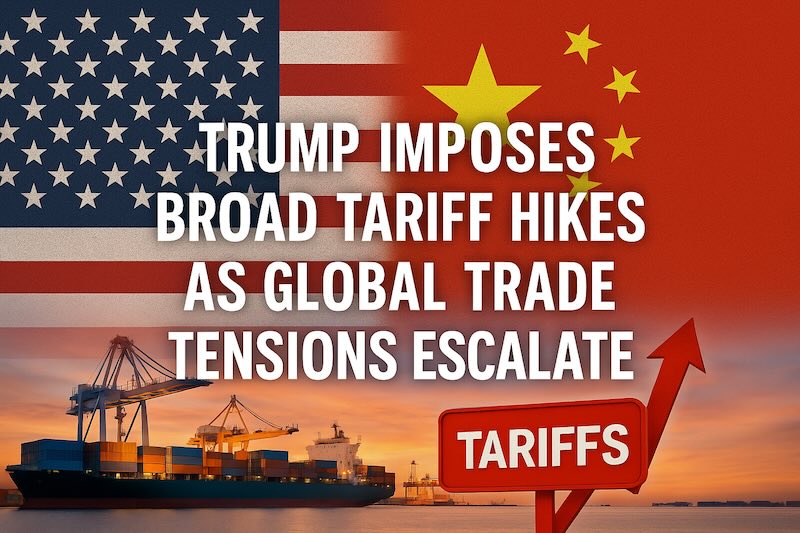Trump Imposes Broad Tariff Hikes as Global Trade Tensions Escalate
President Trump has raised U.S. tariffs to an average of 15.2%, targeting Canada, Asia, and Europe, as part of his push to reshape global trade. Markets and currencies reacted with caution amid rising uncertainty.

🇺🇸 Trump Imposes Broad Tariff Hikes as Global Trade Tensions Escalate
President Donald Trump has unveiled a sweeping new set of tariffs that raises the average U.S. duty rate to 15.2%, marking one of the most significant shifts in trade policy in decades. While baseline rates remain 10% for many countries, select trading partners are facing higher tariffs as Trump continues his aggressive effort to reshape international commerce.
⸻
📰 Key Tariff Highlights
• Average U.S. Tariff:
• Rises from 13.3% to 15.2% (up from just 2.3% in 2024, before Trump took office)
• Country-Specific Increases:
• Canada: 35% on select goods (up from 25%), excluding USMCA-covered items
• Switzerland & New Zealand: Higher rates introduced
• Taiwan & South Korea: Facing 20% duties on some products
• South Africa: 30%
• India: 25%
• Vietnam: 20%
• Smaller states like Syria, Laos, Myanmar: 40%+ tariffs
• Exceptions & Extensions:
• Mexico received a 90‑day reprieve to negotiate a broader deal
• China’s current truce expires August 12, with an extension likely
• Auto tariffs for the EU, Japan, and South Korea will drop to 15% from 25%, easing some tension
Most of the new rates will take effect after midnight on August 7, giving U.S. Customs and Border Protection time to implement the changes.
📉 Currency Market Reaction
• Euro (EUR) – Fell 2.8% on the week to $1.1410, its worst performance in nearly three years, amid concern over the economic impact of the U.S.–EU trade deal.
• British Pound (GBP) – Slipped modestly to $1.3480, with investors cautious despite supportive risk sentiment earlier in the month.
• Canadian dollar (CAD) – Held steady near 1.34 per USD, supported by firm oil prices, despite a 35% tariff on select exports.
• Mexican Peso (MXN) – Strengthened temporarily as Mexico received a 90‑day reprieve from 30% tariffs, with USD/MXN dipping below 19.00.
• Swiss Franc (CHF) – Edged lower following a 39% tariff on Swiss goods, reflecting market jitters.
• Asian Currencies –
• Taiwan dollar (TWD) and Korean Won (KRW) led declines after new U.S. duties on semiconductors and electronics.
• Vietnamese Dong (VND) and Thai Baht (THB) faced pressure as regional trade exposure to the U.S. grew.
• Emerging‑Market Pressure – Smaller economies like South Africa (ZAR) and Philippines (PHP) also saw modest weakness as global risk sentiment shifted.
Analysts warn that while tariffs could boost U.S. revenue and favor domestic producers, the long‑term impact may be higher import costs and inflation, with ongoing uncertainty for global trade.
Euro Slides to Multi‑Year Low Against Dollar
The euro is on track for its worst week in nearly three years, sliding 2.8% to around $1.1410, as markets react to the potential economic fallout from Europe’s new trade deal with the U.S.
After touching a three‑year high in early July, the euro has reversed sharply, with traders questioning whether this marks a turning point as the dollar strengthens against all major peers.
⸻
💡 BER Insight
For FX and cross‑border payments:
• Businesses importing from Canada, Asia, and parts of Africa face immediate cost pressures
• USD strength could persist as markets view tariffs as short‑term dollar‑positive
• Exporters to the U.S. may see local currency weakness, creating both risk and opportunity for international payments
Keep an eye on U.S.–China talks and the Mexican 90‑day window, as any new developments could trigger further FX volatility.
⸻
Disclaimer: Please note any provider recommendations, currency forecasts or any opinions of our authors should not be taken as a reference to buy or sell any financial product.
